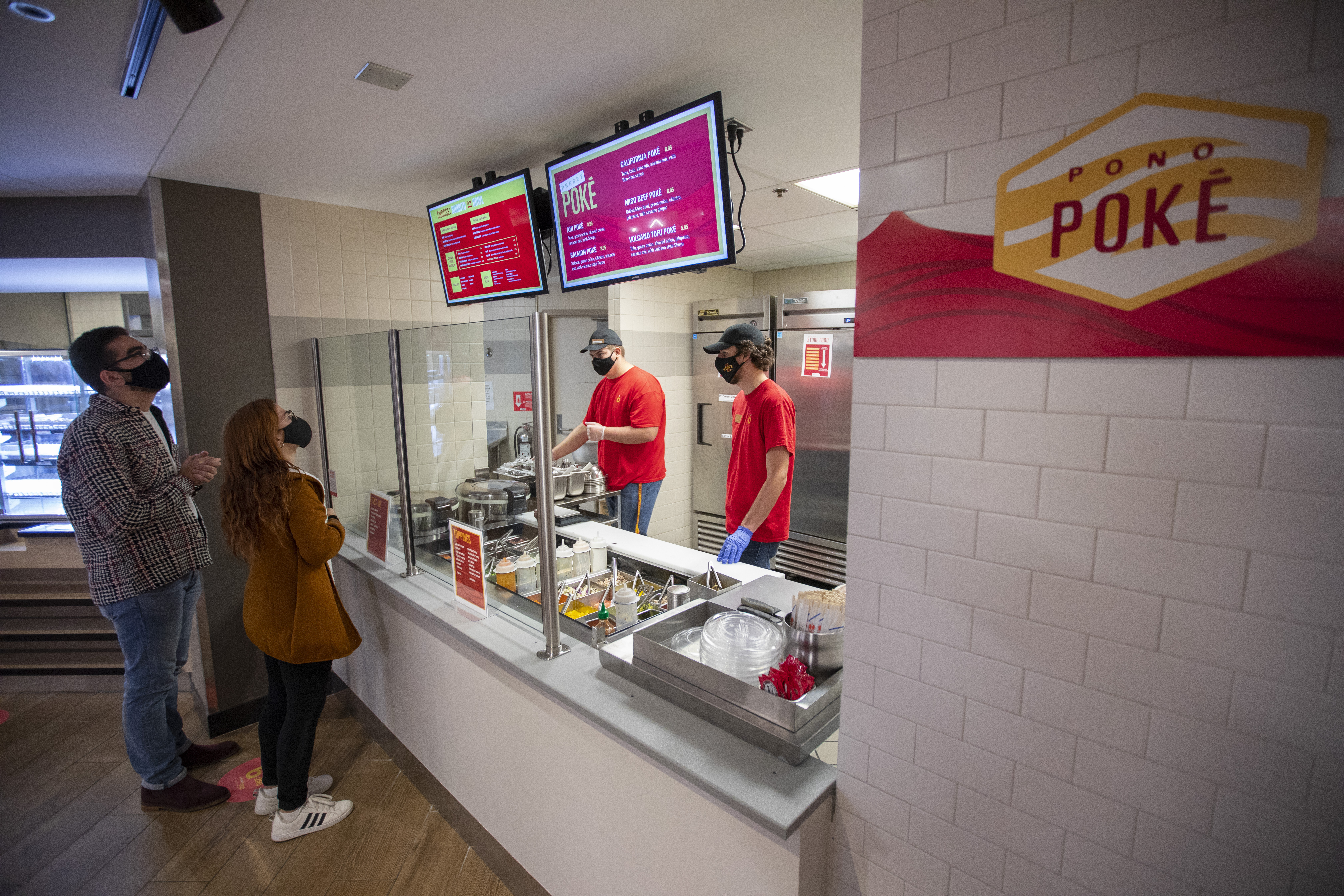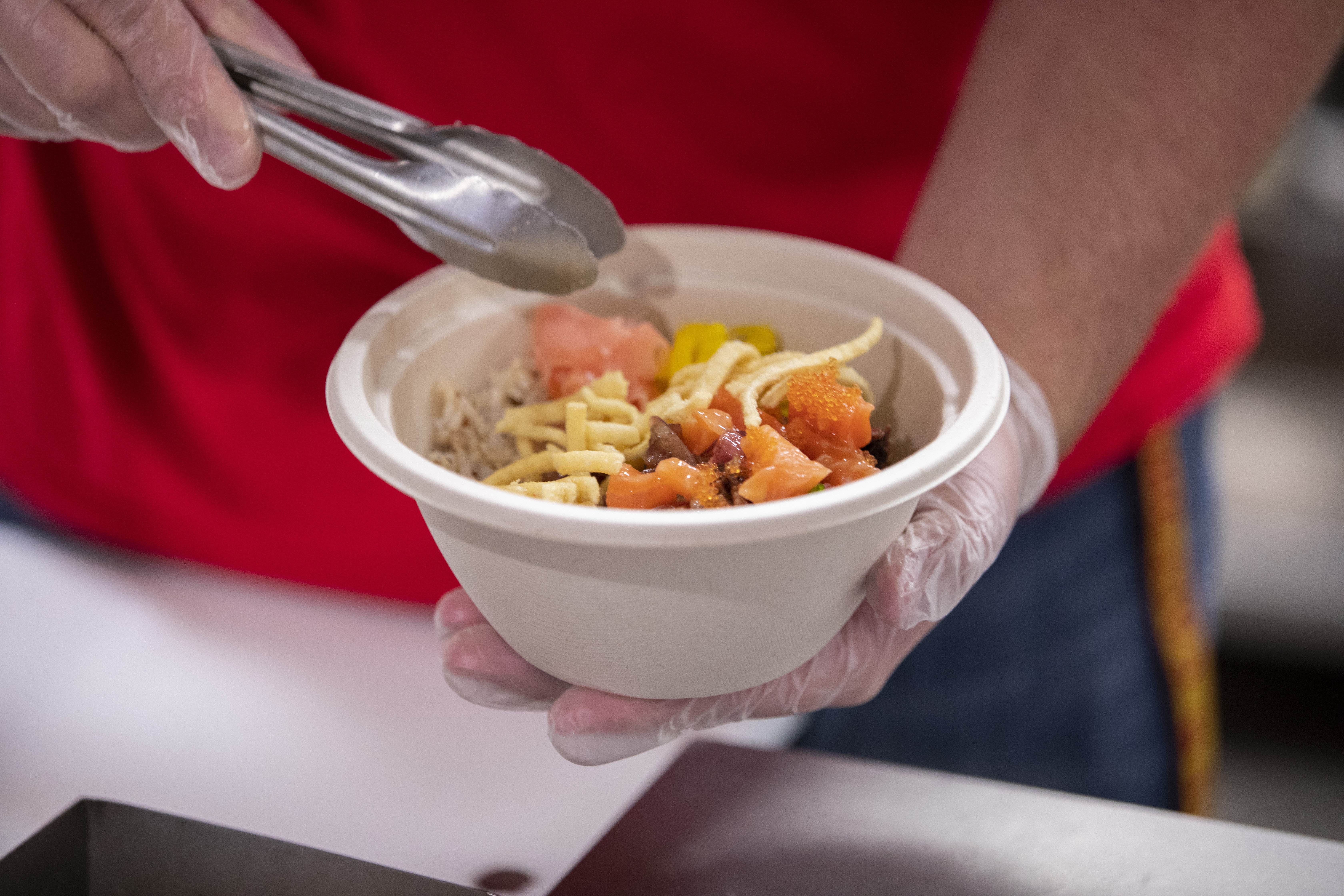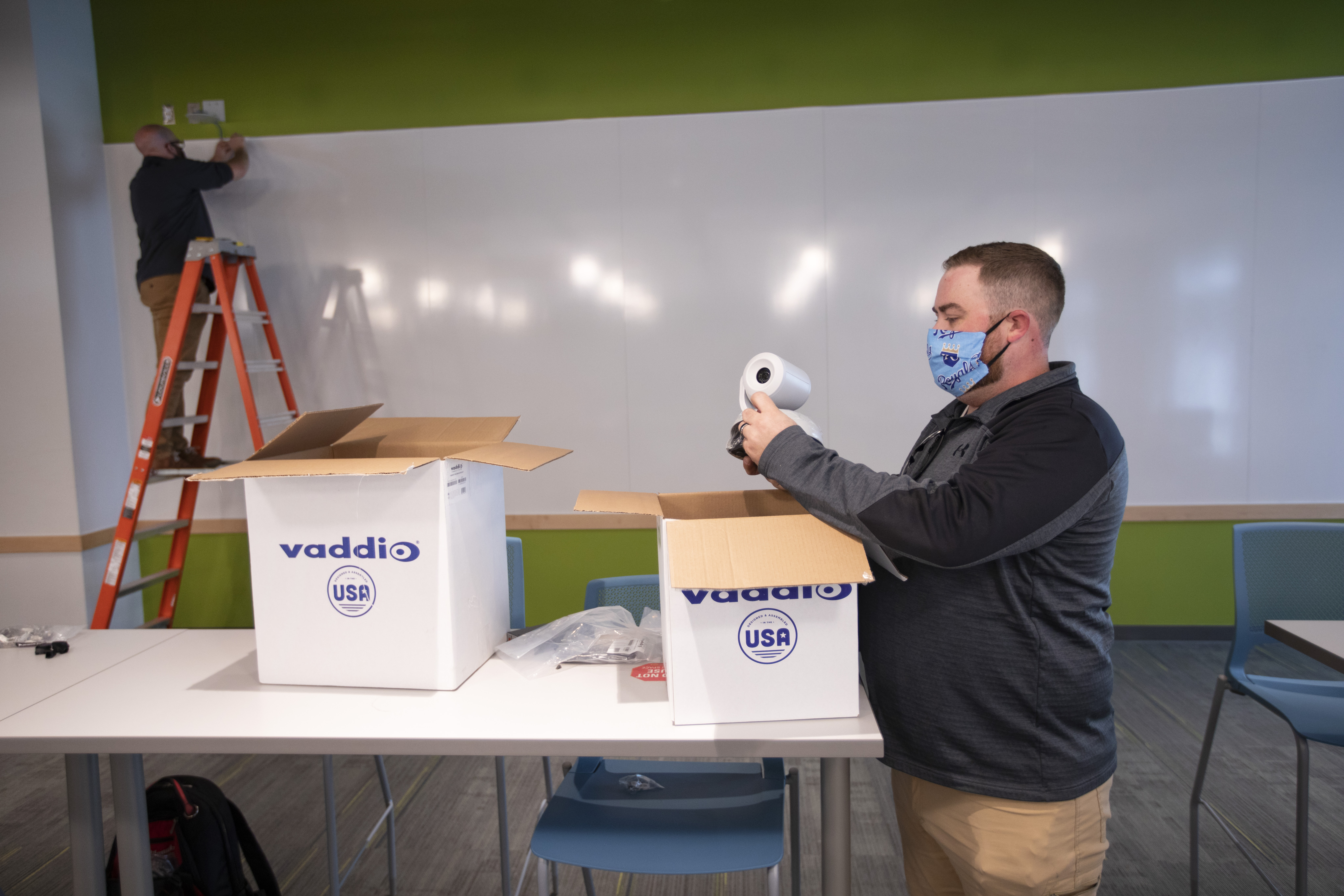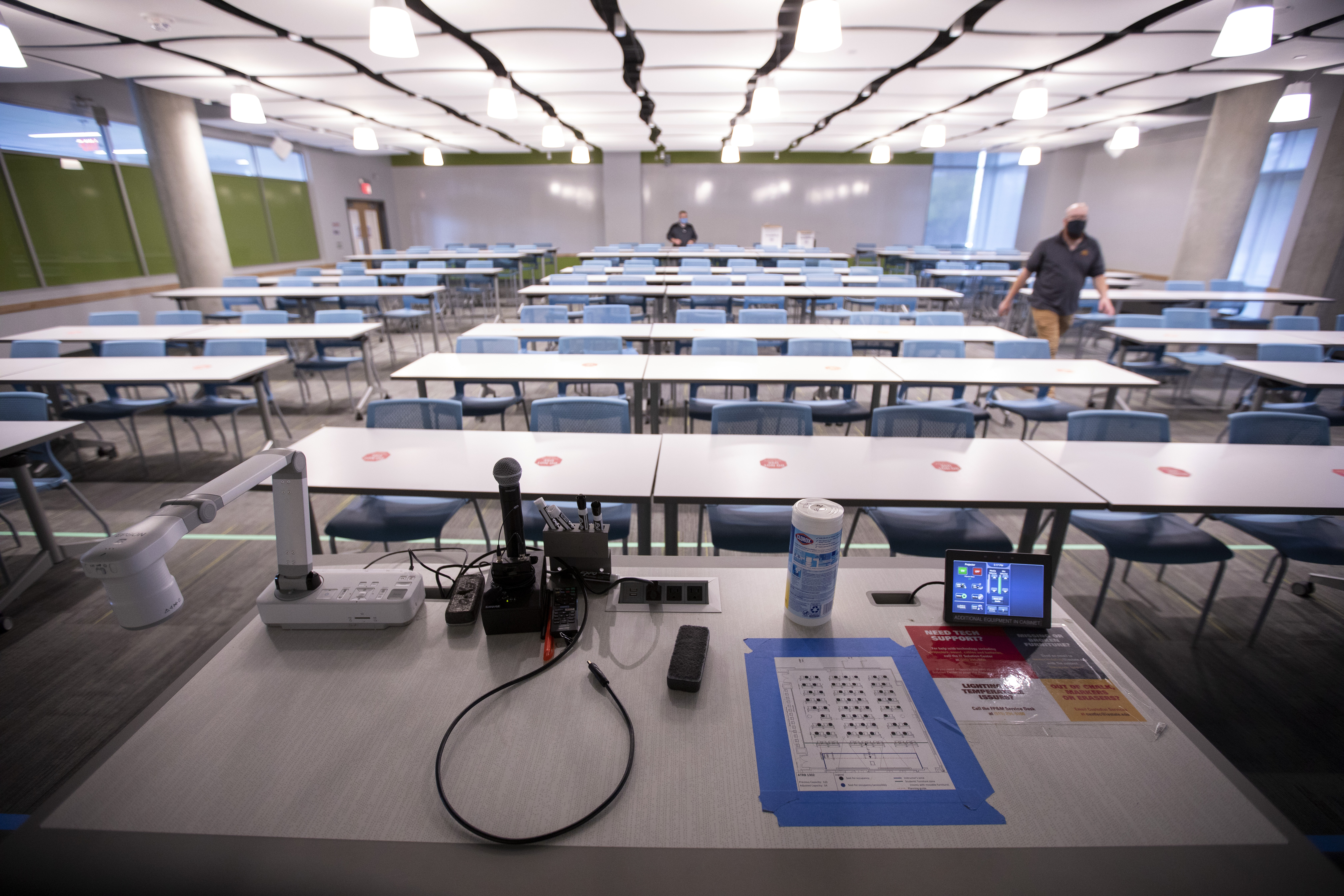Pono Poké brings Hawaiian flavor to MU food court

Senior Ariana Sanchez, on right, studies the menu at Pono Poké, a new restaurant in the Memorial Union food court. Photos by Christopher Gannon.
If there was a way to measure flavor per square foot, that taste density metric would be up sharply this fall in the northeast corner of the Memorial Union food court. In a slot on the food court's perimeter last occupied by a self-serve cooler for soda and grab-and-go items, a new ISU Dining restaurant serves poke, a Hawaiian dish featuring raw fish tossed with seasonings.
Pono Poké, which opened the first week of the fall semester, sells poke-style bowls and burritos with a protein choice that includes two raw fish options -- soy-marinated ahi tuna and sesame-marinated salmon – as well as citrus-poached shrimp, ginger-braised tofu, crab salad and miso-marinated beef tenderloin. Tea-braised chicken will join the menu in a couple of weeks. Bowls come with a choice of white sushi rice, a multigrain brown rice mix or cabbage. Burritos are made with a flour tortilla, soy paper or nori seaweed wrap. Customers can personalize their meal with five sauces, seven toss-ins and 16 toppings.
The first word in the name is Hawaiian and roughly translates as "righteousness." Poke is pronounced poh-kay. It quickly has become a food court top seller, despite the pandemic's reduced overall traffic, said ISU Dining associate director Cheryl Lounsberry. It draws fans of fish and Asian food, plus those looking for a healthy and surprising lunch option.

A burrito at Pono Poké at the MU food court made with a nori seaweed wrap.
"When you think of college dining, you don't think of poke," she said.
Aja Porter may be one of Pono Poké's biggest fans. On a recent Friday, she noted she'd eaten poke for lunch every day that week, a common occurrence. She appreciates the portion sizes and the quality of the ingredients. She said the salmon and tuna compare to what she'd expect in a high-end restaurant.
"You can taste how fresh everything is," said Porter, a catering sales representative for ISU Dining.
Sourcing fish
ISU Dining research and development chef Nolan Green said the salmon is flown in from Norway and processed here in a deep freezer. The tuna comes from a supplier in Minneapolis already "super frozen," meaning it's kept at 20 degrees below or colder. That's so cold that a wet towel placed on the tuna immediately freezes, he said.
It takes specific methods to thaw fish to serve raw safely while maintaining optimum texture, and training for student staff working at Pono Poké is much more extensive than for other ISU Dining locales. Green provides much of that training, applying what he learned working at his uncle's teppanyaki restaurant in San Diego. He grew up in California and Hawaii and discovered poke early in life on the island, when his father would buy some at the grocery store as a weekend treat.
That sparked Green's lifelong appreciation of the traditional Hawaiian dish, which has become more popular in the mainland U.S. in the past decade. He pitched a poke concept for ISU Dining two years ago.
Perfect spot for poke
That made poke a natural pick with some planning already complete when the removal of the grab-and-go coolers left an open spot in the food court.

A poke bowl with salmon from Pono Poké, a new restaurant in the Memorial Union food court.
"We thought, 'What's the best thing we can do without too much cooking or too much prep?' That's kind of where it branched off of," Green said. "It was very quick. There was a lot of work in a short amount of time to get it up and running."
It took about two months to pull off, with renovation starting in late June. A student graphic designer created the Pono Poké look and logo. Luckily, the first shipment of fish hadn't arrived yet when the derecho knocked freezers off line Aug. 10.
Green said the response has been overwhelmingly positive, with busy times even in the typically slow hour before the food court closes at 7 p.m. People stop by to pick up a wrap or bowl for their evening meal, he said.
"Everybody who has had it has for sure come back," Green said.
One of those repeat customers is Ariana Sanchez, a senior in animal ecology, who said Pono Poké is a much-needed addition that helps satisfy cravings for some of her favorite flavors.
"I think it's really ingenious," she said. "This place adds a whole new touch to the food court."
Plans for winter session take shape
Winter is coming. The winter session that is.
As announced in September, Iowa State will offer a special academic session during the extended break between fall and spring semesters.
The session will feature a curated selection of courses that meet core curriculum and general education requirements and were taught by experienced instructors online or in a hybrid format during previous summer terms, senior vice president and provost Jonathan Wickert said.
"Not every course can be compressed into a five-week session," Wickert said. "We want to ensure we're offering a high-quality experience that meets existing learning outcomes and helps students get a leg up on the spring semester and stay on the path to timely graduation."
Key dates for the winter session are:
- Registration: Oct. 26-Nov. 13
- Classes begin: Monday, Dec. 14
- Classes end: Thursday, Jan. 21
- Final exams: Jan. 21
- No classes will be held on university holidays: Dec. 24-25, Jan. 1, 2021, and Jan. 18
A list of winter session courses will be released in the coming weeks, and they'll be available only to continuing students. Students may take up to four credits during the session and will be assessed the standard per-credit and state Board of Regents-approved tuition rate based on their residency status. No differential tuition or mandatory fees will be assessed.
Wickert said students who complete prerequisite courses during winter session may take the next course in the sequence during the spring semester to accelerate their studies.
Executive planning committee named
Planning for winter session is being coordinated by an executive committee chaired by Beate Schmittmann, dean of the College of Liberal Arts and Sciences, and Ann Marie VanDerZanden, associate provost for academic programs. Additional executive planning committee members, and in some cases the five ad hoc subcommittee they're leading, are:
- Tom Brumm, Faculty Senate curriculum committee representative
- Sarah Bennett-George, Faculty Senate academic affairs committee representative
- Shawn Boyne, office of the senior vice president and provost, chair of the academic programs subcommittee
- Kristen Constant, chief information officer
- Laura Doering, associate vice president for enrollment management
- Pete Englin, department of residence, co-chair of the student life subcommittee
- Sharron Evans, dean of students, co-chair of the student life subcommittee
- Erica Fischer, admissions, chair of the communications and marketing subcommittee
- Carly Manz, genetics development and cell biology, faculty representative
- Dan Nettleton, statistics, department chair representative
- Ellen Reints, office of the senior vice president and provost, chair of the tuition assessment and distribution subcommittee
- Diane Rupp, office of the registrar, chair of the implementation and policy subcommittee
Compact but complete
VanDerZanden noted that students who have not taken accelerated courses in the past should carefully consider the daily time commitment that will be necessary before registering for the winter session.
"Most students enjoy the accelerated format because it allows them to focus all their energies on one subject, compared to four or five at a time in the fall or spring," she said. "However, it's important to remember that the reading and coursework for a three-credit course during the winter is the same as for a 14-week course in the spring."
YSS Kids Club to offer school-age child care on campus
Faculty, staff and students struggling to navigate the scheduling challenges of children remotely attending elementary school soon will have support available on campus.
New policy provides up to 80 hours from sick bank if school is closed or remote
A new policy effective Sept. 1 through Dec. 31 allows employees to use up to 80 hours of their existing sick time off to care for children who are:
- Learning remotely as required by the school district
- Attending a school or child care provider closed due to COVID-19
- Home from school or child care due to a medical need connected to COVID-19
For more information on this change and other time off options related to COVID-19, see the time off and leave section of the UHR COVID-19 webpage. It includes guidance and a job aid on using sick time off to support children not in school.
Beginning Oct. 12, Ames-based social services nonprofit YSS will pilot a full-day distance learning care and support program on campus to help elementary-age children with their required online schoolwork. The YSS Kids Club will use four classrooms on the first floor of Ross Hall, enough space for a total initial capacity of up to 45. The program is for children in kindergarten through sixth grade and will run Monday-Friday from 7:30 a.m. to 5:30 p.m.
University human resources (UHR) work-life and family services coordinator Cris Broshar said a consistent theme in a virtual forum she held in late June for faculty and staff who have elementary-age children was a concern about how to manage part-time or full-time distance learning.
"Parents pieced things together in the spring to get to the end of the school year, but many of us were really anxious at the thought of having to do the same thing this fall," she said.
In early August, UHR surveyed employees about their unmet child care needs and began exploring how to help fill a clear gap in care for school-age children. Broshar said YSS seemed like a natural fit because it has provided on-site care for many years with its Kids Club programs before and after school in numerous communities surrounding Ames. Identifying appropriate space on campus and the time YSS needed to hire staff prevented the program from launching earlier in the school year.
"There were lots of things that had to take place before we could move forward with this project," she said.
With enrollment options from one to five days of care per week, Kids Club is designed to be flexible for changing schedules and hybrid instruction plans. Cyclones Care health practices will be followed. YSS will aim to maintain a 10-1 ratio of children per staff member and will not exceed 15-1. The program will be staffed primarily with ISU students.
The center will operate whenever university offices are open, including during breaks and in the summer, if needed. If interest in the program exceeds the initial capacity, plans are in place to expand, Broshar said.
"This will be in place as long as the demand is there," she said.
Standard fees for one child are from $150 per week for five days of care to $45 per week for a single day. YSS uses a sliding-scale cost structure that offers discounts for lower-income families and families enrolling multiple children.
UHR will send an email Oct. 1 to employees with school-age dependents on their ISU Plan health insurance that included the Kids Club parent manual, fee structure and registration packet. To enroll, complete the registration form and email it to kcisu@yss.org. Employees who don’t receive the Oct. 1 email but are interested in the program can email Broshar at cbroshar@iastate.edu. A virtual orientation and Q&A session will be held on Zoom on Oct. 8 at 11:30 a.m. Register online to attend.
Wintersteen endorses sustainability plan for campus operations
President Wendy Wintersteen has endorsed a five-year Strategic Plan for Sustainability in Operations (strategic plan), which identifies overarching strategies through 2025 that reduce the impact of campus operations on the environment. A longer-term goal is carbon neutrality.
The new plan outlines objectives in five areas: energy use and emissions, building operations and maintenance, waste reduction and recycling, grounds maintenance and water use. With a cost-neutral impact to the university, results achievable by 2025 include:
- Reduce greenhouse gas emissions by 50% with the conversion of the last two coal-fired boilers to natural gas. Estimated fuel savings would pay back the project cost in four years. Three boilers already are fueled with natural gas.
- Triple the use of renewable energies.
- Reduce annual building energy consumption by 5% from a 2012 baseline through policy and operational changes and energy-efficient design and construction.
Did you know?
Iowa State is a Princeton Review 2021 "Green College Honor Roll" university, and made Best College Reviews' list of 25 Best Green Colleges.
"The strategic plan upholds our mission to 'create, share and apply knowledge to make Iowa and the world a better place,' fostering a culture of innovation dedicated to sustainable operations," Wintersteen said. "We all must contribute to efforts that respond to the increasing impact of climate change on society, and the strategic plan will guide the Iowa State community on how to do our part.
"I look forward to working further with the University Sustainability Committee and all of you to further the goals of the sustainability framework in the Strategic Plan for Sustainability in Operations as we move to a campus that reflects upon and responds, in our uniquely land-grant way, the path forward on mitigation of climate change."
Campus support
Endorsing the strategic plan was the first recommendation of the University Sustainability Committee Wintersteen appointed last winter. Meteorology professor Bill Gutowski, a climate expert, chairs the committee of 20 faculty, staff and students.
In its recommendation, the committee encouraged Wintersteen and senior leaders "to keep an open mind about issues that involve budgetary concerns; some measures of the plan will require funds but others will save money, and those can be implemented first."
The strategic plan itself was drafted, presented to campus groups and revised from 2017 to 2019 by director of sustainability Merry Rankin and the advisory committee on sustainability, variations of which have operated on campus for more than a decade. During this same window, the Student Government and Faculty Senate approved resolutions supporting a carbon neutral university.
Rankin said the strategic plan is tied closely to university applications to the Association for the Advancement of Sustainability in Higher Education's STARS (Sustainability Tracking, Assessment and Rating System) program. She pulled out five program areas that best fit the university's mission while offering opportunities to excel operationally. Rankin called STARS "the only recognition program that provides a full campus perspective benchmarking -- the breadth and depth of environmental, economic and social sustainability," and reflects not only leadership on policies and procedures but also individual consumption choices.
Iowa State earned three consecutive STARS Gold certifications (2013, 2016, 2019), the most recent valid through 2022. Rankin said achieving goals in the strategic plan will move the university toward STARS' highest level, platinum. And by linking the strategic plan to STARS certification, Rankin said the university has a two-tiered benchmarking system: year-to-year changes and collective gains since 2012, the date of the first STARS application.
She said the advisory committee on sustainability, with a subcommittee structure mirroring the strategic plan's five areas, is prepared to carry out the research, planning and educating required by the strategic plan, in collaboration with the University Sustainability Committee. Plans and procedures still need to be developed to achieve noteworthy, university-wide efficiency in the operational areas of waste reduction and diversion, water conservation and grounds maintenance.
Video systems will soon be a classroom mainstay

Information technology services employee Casey Weldon, right, examines a new classroom camera while colleague Phil Kuhlman prepares its mount wiring at rear in a classroom inside the Advanced Teaching and Research Building on Sept. 28. Photos by Christopher Gannon.
A small information technology services (ITS) team over the last two months has outfitted more than half of the general university classrooms in use this fall with video cameras and microphones to record or livestream in-person teaching.
But when he thinks about the sweeping project to make classrooms more suitable for distance learning and hybrid instruction, the remaining work weighs heavier on Mike Pedersen's mind than satisfaction about what's been accomplished.
"It keeps me up at night that we still have rooms that don't have this technology," said Pedersen, manager of the ITS audiovisual experience team. "While we're proud of what we've done, we also recognize there's a lot undone. We're doing what we can, and it's taken longer than we expected."
The audiovisual team aims to have video equipment installed by mid-October in each of the 147 in-use general university classrooms. As of Sept. 30, 77 were up and running. Some colleges and departments also are adding similar video capabilities in the seminar and laboratory spaces they manage, Pedersen said.
While instructors have been patient and understanding, Pedersen hopes a burst of installations over the next couple of weeks will complete all classrooms with a chunk of the fall semester still left.
"We have a ton of internal pressure on ourselves to get these finished," he said.
Getting in gear
The seeds of the project were planted in the spring shift to virtual instruction. Thinking that in-class video recording may be essential during the pandemic, the audiovisual experience team surveyed the 207 general university classrooms in mid-March and found only 17 were equipped for lecture capture. Pedersen said he knew it would be a low number, but he wasn't sure how low. There had never been a reason to do an inventory.
Pedersen at first proposed a limited project, installing video recording systems with remote control camera movement in 20 of the largest lecture halls. After consulting with his counterparts at other state Board of Regents universities, he found a different cost-effective option for expanding video capability to all general university classrooms. An order for the higher-end equipment with remote control was placed in late June, and the first sets of the lower-cost setups were ordered in early July.
It was immediately clear that the gear couldn't be acquired quickly. Backlogs mounted as demand spiked for video recording. Shipping delays were 10 weeks in some cases, Pedersen said.
"We weren't the only college thinking through this. Everybody and their dog was thinking through this," he said.
Two levels of tech
Current plans would furnish 39 large classrooms and lecture halls with the more sophisticated level 1 system. That includes a motorized remote camera with pan, tilt and zoom as well as integrated audio that connects to the existing microphones classrooms already have for in-class amplification. Some systems also connect to a cloud-based platform that automatically records class sessions. Twenty-seven of the level 1 classrooms are complete, as of Sept. 23.
The other 108 university classrooms will have simpler level 2 systems, which includes a camera and microphone that connect to a laptop or other device by USB. The microphone is stationed at the classroom's teaching area, so instructors can't stray too far if they're recording or livestreaming. Fifty of those systems have been installed.
Depending on what already is in the classroom, a level 1 setup costs between $10,000 and $20,000, Pedersen said. Level 2 systems run about $500. Money initially budgeted for other fiscal year 2021 audiovisual upgrades has covered most of the cost of the video project.
ITS is maintaining an updated online list of general university classrooms that identifies the video system in each classroom and, in rooms where the installation hasn't happened yet, a tentative schedule and the type of system planned.
Laminated instructions for each type of system are attached to teaching stations in every classroom. The level 1 and level 2 instructions also are available online. Alcohol wipes were placed in each classroom for instructors to sanitize the equipment before and after class.
Long days
While obtaining the equipment slowed installation at first, the time that installation takes also has been a factor, with just three audiovisual team employees working on campus, Pedersen said.
The level 2 systems take about an hour to set up. The level 1 systems can take up to 10 hours, Pedersen said. Since the level 1 rooms are large and in demand, completing an install without interruption on a weekday while classes are in session isn't possible.
"We've had to split it up and do it in chunks," he said.
Trying to get as much done as possible before the semester, combined with the usual start-of-the-year testing of classroom audiovisual equipment, made for a heavy workload in August, Pedersen said. That was complicated by the Aug. 10 derecho, as audiovisual systems sometimes don't respond well to abrupt power outages.
"There were a lot of long, long days in the three weeks leading up to classes starting. We were here on nights, weekends," Pedersen said.
While the project has been daunting, the feedback the team has received from faculty has been encouraging.
"A few times we've done some one-on-one coaching on how to use the system, and once we're done walking through it, the response typically is, 'Wow, this is really great. This is going to be helpful,'" Pedersen said.

All general university classrooms, such as this one in the Advanced Teaching and Research Building, are being equipped with equipment to record and livestream videos during class.
Closed-captioning service available through central source
Iowa State has another tool to help make video content more accessible to hard-of-hearing and deaf viewers. Cyndi Wiley, digital accessibility coordinator in information technology services (ITS), collaborated with the other state Board of Regents institutions to secure a closed-captioning service contract this summer.
The captioning service -- for recorded videos, not live broadcasts -- is provided by Rev, a company with headquarters in Austin, Texas, and San Francisco. Rather than generating automated captions, Rev's closed captioning work is done by freelancing experts. The service is available 24/7 and the company guarantees a minimum 99% accuracy.
With the combined buying power of the regent institutions, Wiley secured a prepaid bank of service minutes at a discounted price. ISU's $1.06 per minute rate is 15% less than Rev's advertised cost. Departments and units need a worktag to submit a request to use the Rev minutes. Directions for using the closed-captioning service are on the ITS knowledge base site.
Automated vs. people-powered captioning
Wiley said speech recognition programs that auto-generate text require editing before publishing. While cost-effective (in many cases free), the time it takes to upload, generate and edit the automated captions isn't the best approach for videos more than 20 minutes in length.
"The larger and longer the video, the more time it will take to upload, process, run auto-generated captions and human edit before publishing. File sizes for videos tend to be large and will take more time to upload depending on length and resolution of the video. A typical amount of time needed for editing and adding captions is two to three times the length of a video," Wiley said. "In cases where the videos are longer than 10-20 minutes, it might be helpful to outsource the captions to a service like Rev."
Automated speech recognition (ASR) platforms have difficulty with multiple speakers, low-quality microphones, nonnative English speakers and content with equations and formulas. "Some ASR platforms run on more advanced artificial intelligence and the error rate is less. However, the accuracy never achieves 99%," she said.
Wiley said captioning is an important part of creating video content, pointing to research that shows most faculty, students and staff with and without a disability use it -- leading to an increase in learning when captions are accurate.
Extension finds new ways to reach Iowans
ISU Extension and Outreach knew the pandemic would impact the way many of its specialists did their job. Rather than reject new ideas, extension embraced them.
One of the ways extension is getting information to Iowans is the "Tips from an Expert" Facebook Live series. The live event hosted on Facebook gives anyone a chance to get questions answered by extension experts.
"We have a lot of information that would be beneficial to Iowans right now," extension social media specialist Leah Feltz said. "Extension is research-based, so there are times that it takes a little bit longer to get that resource into the hands of people."
The virtual event eliminates that delay, allows people to ask questions important to them and puts a face with a name at a time when many extension specialists have little in-person interaction, Feltz said.
Live events
Extension began hosting the sessions in May, which last from 20 minutes to an hour-plus. Topics range from gardening to parenting during a pandemic to recovery from the derecho. Feltz lets need, rather than a schedule, dictate when a session will happen, having completed nine since May.
"I do a lot of social listening with my job, so I am one of the first extension employees to see a route we should go," she said.
The events are live, but archives allow viewers to take in the information on their schedule. Feltz, who moderates the sessions, follows up on questions posted after the event to get them answered.
Topics have drawn more than 60 live viewers, but several have more than 2,000 views once archived. Feltz continues to make adjustments as more people return to work.
"We are still working on things like what is the best day or time to have these sessions," Feltz said. "We see consistent engagement that shows it is worth our time, and we are reaching audiences we have connected with in addition to new audiences maybe extension hasn't traditionally connected with."
Trying new things
Facebook Live sessions are just the latest way extension is pivoting to reach Iowans online. With so many events going virtual -- including field days -- extension staff have shown their willingness and ability to communicate through new channels.
"Our state and county staff really embraced virtual education," Feltz said. "When March came around, they had to do a pretty abrupt U-turn to reach their audience."
That led to the creation of new extension YouTube channels and expanded podcast offerings from one to eight. It has been especially important in recent months with Iowans dealing with more than just a pandemic.
The expanded digital offerings reach a new generation of younger people more likely to consume information on their phone or tablet than walk into their local extension office.
"We have a big tie-in with agriculture, but we have something for everyone, and I think it has been fun to see those new connections develop," Feltz said.
New option available for voluntary retirement savings
Iowa State employees have a new option for socking away retirement savings via payroll deductions.
Starting Oct. 1, a 457(b) plan also will be available as part of the university's voluntary retirement savings plan, which previously offered only a 403(b) plan. Contributing to those plans is an optional way for employees to supplement required retirement fund deductions for either their defined-contribution TIAA account or their defined-benefit Iowa Public Employees' Retirement System pension.
Adding a 457(b) plan provides another way to save for retirement using automatic payroll deductions, an especially beneficial option for faculty and staff who have maxed out their contributions to their 403(b) account.
Similar to 401(k) accounts but for public-sector employees, 457(b) and 403(b) plans can have slightly different rules. However, the university's offerings are the same for both. Neither plan allows penalty-free withdrawals, and they have the same general catch-up provisions. Contributions to either plan can be made on a pretax basis or as a Roth account, which is subject to taxes now but will be withdrawn tax-free in retirement.
Two of the three vendors who offer 403(b) accounts -- AIG and TIAA -- also will offer a 457(b) option. The investment funds available and account fees will be the same.
The university does not match funds contributed to voluntary retirement savings plans. A minimum $20 monthly contribution is required to participate.
Contributions to voluntary savings accounts can be changed at any time through Workday. A job aid outlines the process. An FAQ also is available. For questions about the voluntary retirement savings program, contact the payroll, benefits and tax office at fbac@iastate.edu.
Virtual Homecoming still has familiar traditions

The Victory Lane tradition dating back to the 1980s will continue even though Homecoming -- Oct. 4-10 -- has a different feel this year. Alumni, employees, friends and future Cyclones can virtually paint Victory Lane by submitting a drawing by Oct. 1 that represents the 2020 theme: Cardinal and BOLD.
A square to help cover the traditional grid in the Iowa State Center parking lot can be done on paper, canvas, a sidewalk or any other creative way Cyclones can think of. Take a photo of the design and email it to be part of the gallery for all to see.
There is a full week of activities -- including Cyclones Everywhere bingo and virtual campaniling -- celebrating Homecoming, culminating in the football game against Texas Tech at 2:30 p.m. Saturday, Oct. 10. The Homecoming game was originally set for Oct. 17, but the schedule changed due to the pandemic, said Carole Gieseke, assistant vice president of communications at the alumni association.
"I think alumni love the Homecoming traditions," Gieseke said. "This year will be completely different with not a lot of people coming back, but we want the alumni to still feel like it is a special time of year."
The Homecoming Central Committee -- made up of current ISU students -- helped plan virtual events to get as many Iowa State alumni involved as possible.
"While we wish that we could hold events in-person, we are proud to partner with our Homecoming Central Committee students to provide familiar traditions to Cyclones everywhere and some new opportunities that may continue in future years," assistant vice president for constituent engagement Katie Lickteig said.
Despite a mostly virtual format, Homecoming buttons still can be ordered. Digital Homecoming swag also is available for free download.
